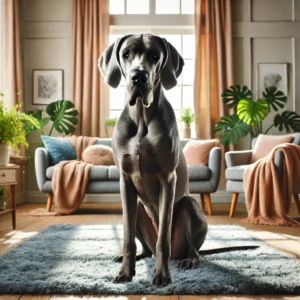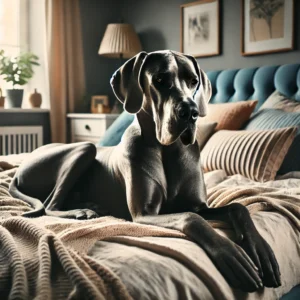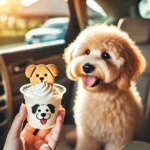Blue Great Dane: A Gentle Giant with a Striking Coat
The Blue Great Dane is a stunning variation of the majestic Great Dane breed, known for its calm, loving personality and, of course, its beautiful blue-gray coat. Great Danes are one of the largest dog breeds, often referred to as “gentle giants” because of their immense size combined with their gentle, friendly nature. If you’re looking for a dog that’s both a head-turner and a loving companion, a Blue Great Dane could be the perfect choice for you!
In this article, we’ll explore everything you need to know about Blue Great Danes, from their history and appearance to their temperament and care needs. Whether you’re considering bringing one into your home or just want to learn more about this amazing breed, you’ll find all the information you need right here.
A Little History: The Great Dane Breed
Before diving into the unique features of the Blue Dane, it’s helpful to know a bit about the breed’s origins.
Great Danes have a long and noble history that dates back over 400 years. Originally bred in Germany, they were used as hunting dogs, particularly for hunting wild boar. Over time, breeders focused on making the Great Dane less aggressive and more companionable, resulting in the gentle, affectionate giants we know and love today. The breed is recognized for its loyalty, elegance, and calm demeanor, making it a popular choice for families.
The Blue Great Dane, specifically, gets its unique color from a recessive gene that produces a beautiful blue-gray coat, which makes these dogs even more special and distinctive. related post
What Makes a Blue Great Dane Special?
The Stunning Blue Coat
One of the most remarkable features of the Blue Dane is, of course, its coat. The blue coloration is a diluted form of black, giving these dogs a sleek, silvery-blue appearance. Their coat is short and smooth, making them relatively low-maintenance when it comes to grooming. While the color is described as “blue,” it can range from a light gray-blue to a deeper steel-blue shade.
The blue coat is a genetic rarity, which makes Blue Great Danes highly sought after by dog lovers. Whether they’re out on a walk or lounging at home, these dogs always stand out because of their striking appearance.
Personality and Temperament
Despite their size, Blue Danes are known for being gentle, calm, and incredibly affectionate. Here’s what you can expect from the temperament of a Blue Great Dane:
- Gentle Giants: Blue Great Danes may look imposing, but they are known for their calm and loving nature. They are often called “gentle giants” because they are very gentle with their families, including children. They’re protective but not aggressive, making them excellent family pets.
- Loyal and Affectionate: These dogs form strong bonds with their families. They love to be close to their owners, whether it’s lying by your feet or snuggling up for a nap. Blue Great Danes thrive on attention and affection, and they’ll be happiest when they’re spending time with their favorite people.
- Playful Yet Calm: While they enjoy a good play session, Blue Great Danes are not overly energetic. They’re happy to run around and play outside, but they also know how to relax indoors, making them well-suited for both active and laid-back households.
- Intelligent and Trainable: Blue Danes are smart dogs who are eager to please. This makes them relatively easy to train, especially when positive reinforcement techniques are used. They respond well to praise, treats, and consistent routines.
Family-Friendly Nature
One of the best things about Blue Danes is how well they fit into family life. Their gentle and patient nature makes them wonderful companions for children. They’re protective without being aggressive, which means they can provide a sense of security while remaining friendly and approachable.
It’s wonderful to note that despite their large size, Blue Great Danes are naturally gentle and loving. While they may occasionally nudge smaller children during play, their sweet and caring nature means they can easily learn to be more mindful, ensuring fun and safe interactions for the whole family. However, they’re generally very aware of their size and tend to be careful around kids. Supervised interactions, especially when your Blue Great Dane is a puppy, can help foster a strong bond between your dog and your children. Related post
How to Care for Your Blue Great Dane
Caring for a Blue Dane is not difficult, but there are a few key things to keep in mind to ensure your gentle giant stays happy and healthy.
Exercise Needs
Although they are a large breed, Blue Great Danes don’t have extremely high energy levels. They require regular exercise, but they’re not as active as some other large breeds, such as Border Collies or German Shepherds.
- Daily Walks: Your Blue Great Dane will benefit from a couple of moderate walks each day. These walks don’t need to be overly long, but they are essential for keeping your dog fit and happy.
- Playtime: In addition to walks, your Blue Great Dane will love some playtime, whether that’s playing fetch in the yard or having fun with interactive toys. Mental stimulation is also important to keep them sharp.
While exercise is important, it’s equally essential to avoid over-exercising your Blue Great Dane, especially when they are puppies. Since their joints and bones are still developing, it’s important to provide them with gentle exercise. Avoiding overly strenuous activity during their growth phase helps ensure strong, healthy joints as they mature, reducing the risk of joint issues later in life.
Grooming
The Blue Dane’s short coat makes grooming relatively easy. Their sleek blue coat doesn’t shed excessively, but regular grooming will help keep them looking their best.
- Brushing: Brush your Blue Great Dane’s coat once or twice a week to remove loose fur and keep their coat smooth and shiny. A rubber curry brush or a soft bristle brush works well for this breed.
- Bathing: Bathing is only necessary every few months or when your dog gets particularly dirty. Their short coat is easy to clean, and regular baths will help keep them fresh and odor-free.
- Nail Trimming and Ear Cleaning: Regularly trim your Blue Great Dane’s nails to prevent them from becoming too long. Also, check and clean their ears regularly to avoid any infections.
Feeding and Nutrition
Because Blue Great Danes are large dogs, they need a balanced diet that supports their growth and health. While a healthy diet is essential, managing portion sizes is key to preventing obesity, which can put extra strain on your Blue Great Dane’s joints and overall well-being.
Portion Control: Opt for high-quality dog food formulated for large breeds, and feed your Blue Great Dane smaller, balanced meals throughout the day. This helps not only in maintaining a healthy weight but also in preventing bloating, ensuring your dog stays comfortable and full of energy.
Hydration: Make sure your Blue Dane always has access to fresh water, particularly after playtime or meals, to keep them well-hydrated and happy.
Consult with your veterinarian to determine the best diet for your dog, based on their age, size, and activity level.
Health Considerations
Like all breeds, Blue Danes can be prone to certain health conditions, but with proper care, you can help ensure your dog stays healthy and happy for years to come.
- Hip Dysplasia: While hip dysplasia can sometimes occur in large breeds, maintaining a healthy weight and providing regular exercise can help support strong joints. With proper care and attention, you can ensure your dog stays active and comfortable throughout their life! Regular vet check-ups and maintaining a healthy weight can help manage or prevent this condition.
- Bloat: While bloat, also known as gastric torsion, can occasionally affect large breeds like the Great Dane, you can easily reduce the risk by feeding smaller, more frequent meals and allowing your dog to rest after eating. With these simple precautions, you can help keep your Great Dane healthy and comfortable
- Heart Health: Great Danes can be prone to heart issues, particularly dilated cardiomyopathy (DCM). Regular vet visits and monitoring your dog’s health can help catch any problems early.
Training Your Blue Great Dane
Training your Blue Great Dane is a rewarding experience, as these dogs are intelligent and eager to please. Start training your puppy as soon as possible to establish good behavior early on.
- Positive Reinforcement: Use treats, praise, and affection to reward good behavior. Blue Great Danes respond well to positive reinforcement and will quickly learn new commands when training is fun and rewarding.
- Consistency: Be consistent with your training commands and routines. Blue Great Danes are creatures of habit and will thrive when they know what to expect.
- Socialization: Early socialization is important for your Blue Great Dane. Expose them to different environments, people, and other animals from a young age to help them become confident and well-rounded dogs.

Why Choose a Blue Great Dane?
There are so many reasons why a Blue Dane could be the perfect addition to your family. Here are just a few:
- Affectionate Companions: Blue Danes are incredibly loving and loyal. They will form deep bonds with their families and are known for their gentle, affectionate nature.
- Calm and Relaxed: While they enjoy playtime, Blue Great Danes are also known for their calm demeanor. They’re just as happy to relax with you at home as they are to go for a walk or play outside.
- Unique Appearance: Their stunning blue coat sets them apart from other dogs, making them a truly unique and beautiful companion.
- Great with Families: Blue Danes are excellent with children and other pets. Their patience and gentle nature make them a wonderful choice for families.
Conclusion
The Blue Great Dane is a magnificent and loving dog that makes a wonderful addition to any home. With their stunning appearance, gentle personality, and deep loyalty, they are sure to bring joy and companionship to your family. Whether you’re looking for a playful companion or a calm, affectionate friend, the Blue Great Dane is a perfect choice. By providing them with proper care, love, and attention, you’ll have a loyal and loving companion for many years to come!



Pingback: Parti Poodle Dogs 7 Surprising Traits to Love Adorable Breed
Pingback: Pup Cup: 5 Awesome Reasons Your Dog Will Love This Treat